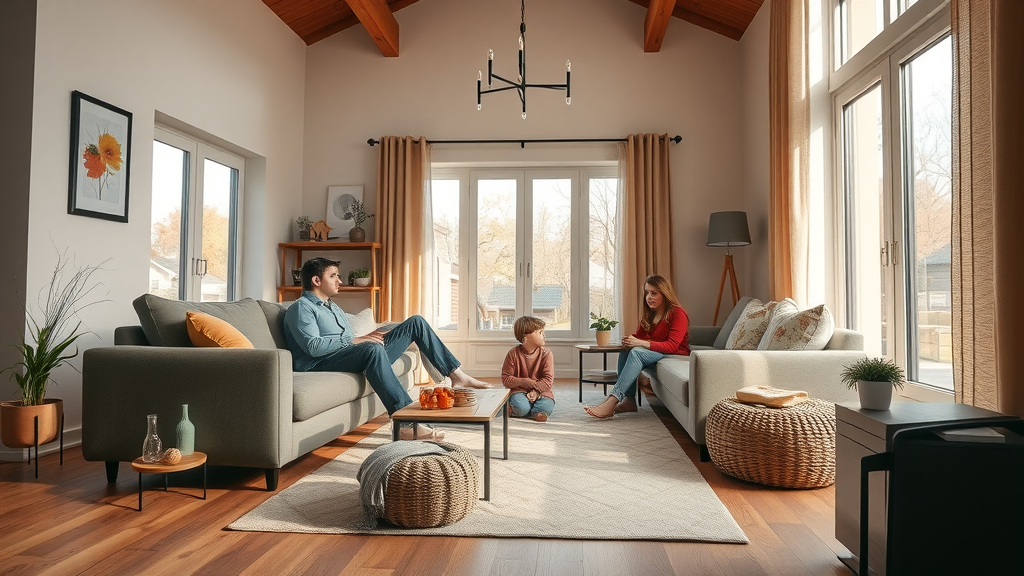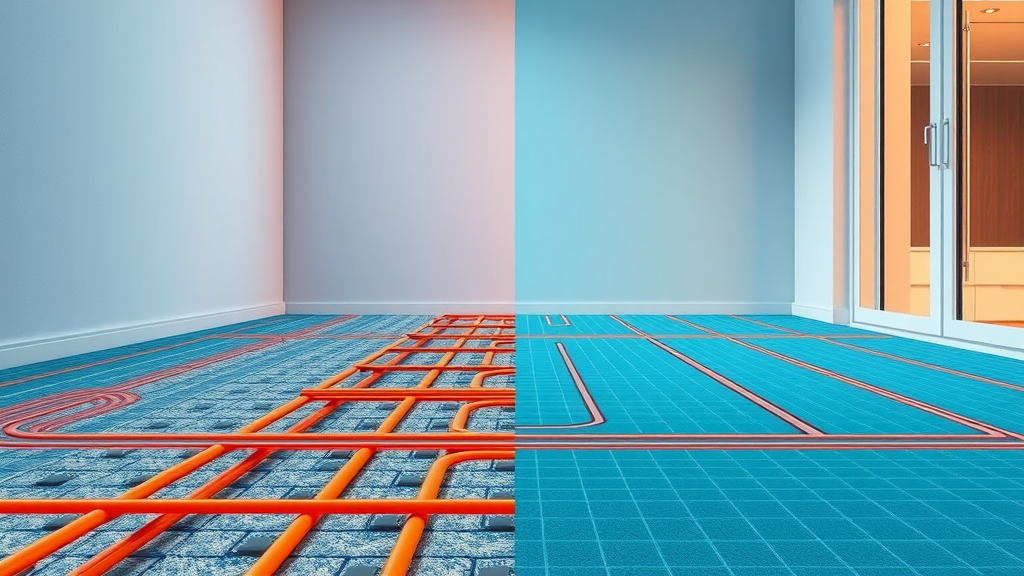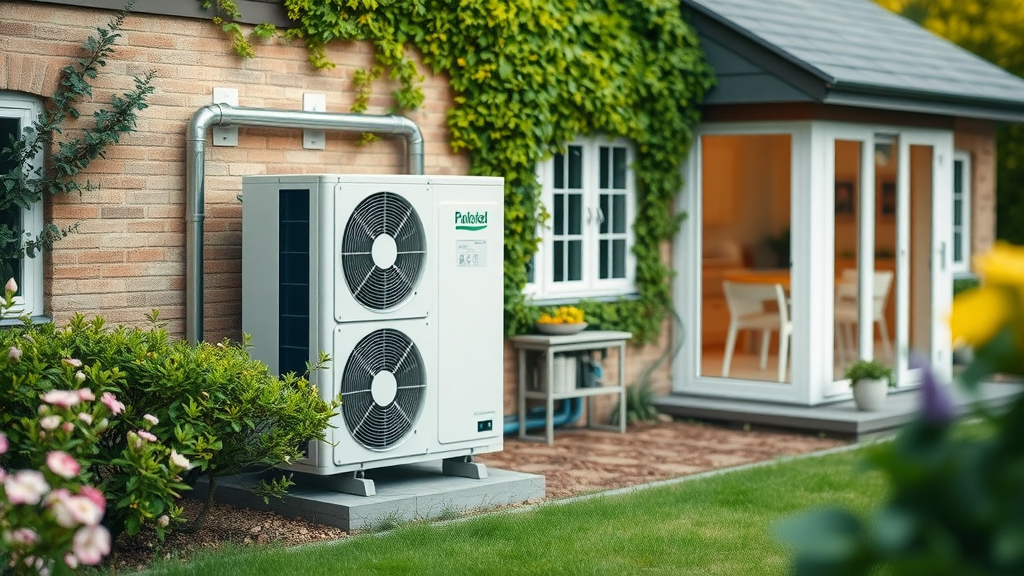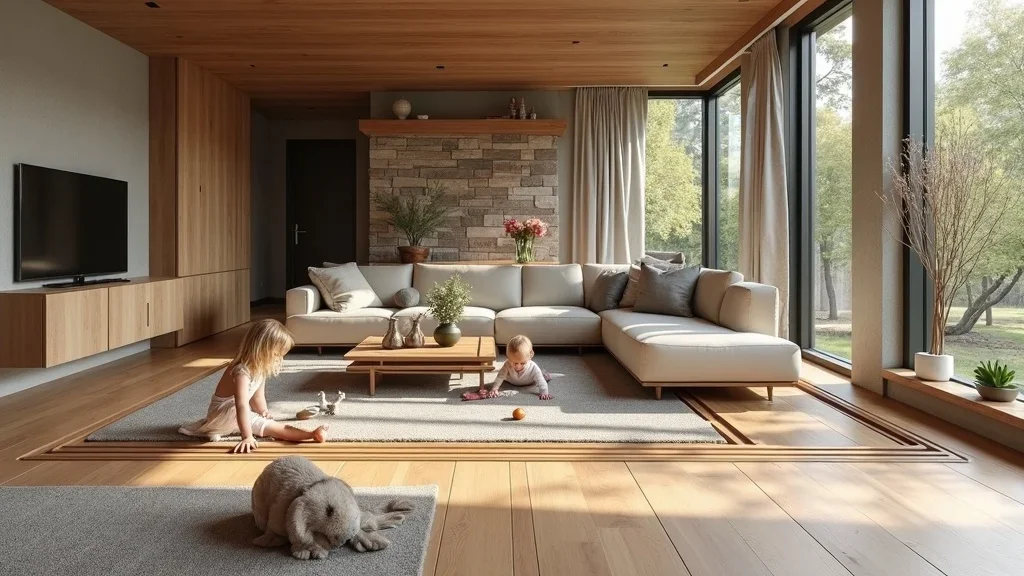
What if you could lower your energy bills by 25% just by switching to a different heating system? It’s not just wishful thinking—many Chesterfield homeowners are discovering that underfloor heating brings this statistic to life. Beyond lower bills, underfloor heating benefits Chesterfield properties with greater comfort, a cleaner home environment, and increased property value. Ready to learn why it’s quickly becoming the top choice for modern homes? Let’s get started.
Underfloor Heating Benefits Chesterfield Homes: Unveiling an Unexpected Advantage
- Did you know? According to UK industry reports, homes with underfloor heating can experience up to 25% lower energy bills compared to conventional heating systems. Explore how underfloor heating benefits Chesterfield residents both economically and comfortably.
For Chesterfield homeowners seeking both savings and comfort, underfloor heating proves to be a game changer. Traditional radiators can leave cold spots and unevenly heated rooms. In contrast, underfloor heating systems distribute warmth evenly across every inch of your floors, creating a consistent and cozy atmosphere throughout the house.
The financial benefits are just as impressive. Not only do these heating systems operate at lower temperatures and use energy more efficiently, but they also help reduce your overall heating bill . For anyone looking to upgrade or build a home in Chesterfield, underfloor heating is a must-consider feature that can future-proof your home for years to come.
Why Underfloor Heating Benefits Chesterfield: A Practical Guide
Key Heating System Improvements with Underfloor Heating
- Enhanced energy efficiency
- Even heat distribution
- Lower running costs
- Suitable for new builds and renovations
One of the primary reasons underfloor heating benefits Chesterfield homes lies in the remarkable upgrade to your heating system . Older central heating units and radiators fail to match the hybrid of comfort and efficiency these systems bring. With improved insulation and energy efficiency , underfloor heating systems run at lower temperatures while still delivering the same warmth, which slashes your utility costs.
The system warms your rooms from the floor up, ensuring every corner stays toasty and eliminating troublesome cold spots . Whether you’re installing in a new build or retrofitting during renovations, the flexibility and efficient heat delivery of underfloor heating make it a practical and attractive solution for every Chesterfield home.

How Underfloor Heating in Chesterfield Outperforms Traditional Heating Systems
- Comparison of radiators vs underfloor systems
- Longevity and maintenance considerations
- Impact on home value in Chesterfield
When comparing underfloor heating systems to traditional radiators, the difference is clear. Radiators often create uneven warmth and use more space, which can affect your interior design choices and furniture placement. Underfloor heating is hidden beneath your floors, providing even heat distribution and freeing up valuable wall space for a modern, uncluttered look.
Maintenance is also simpler and less costly in the long term. While radiators and conventional systems may require frequent servicing, high-quality underfloor heating installation only needs occasional checks—to keep everything running smoothly for decades. In the Chesterfield property market, buyers actively seek out features like energy efficiency and modern heating systems , making underfloor heating a smart investment to enhance both value and desirability of your home.
Types of Underfloor Heating Systems: Which Suits Your Chesterfield Home?
Water Underfloor Heating Systems vs. Electric Underfloor Heating
- Water-based underfloor heating system: Pros, cons, best applications
- Electric underfloor heating: Pros, cons, best applications
Choosing between a water underfloor heating system and an electric underfloor heating system depends on your home’s size, layout, and energy goals. Water underfloor heating (also known as hydronic underfloor heating) circulates warm water through sturdy pipes embedded beneath the floor, making it perfect for large areas and new constructions. The benefits include low running costs, high compatibility with modern boilers or heat pumps , and excellent energy efficiency in bigger spaces.
On the other hand, electric underfloor heating uses thin heating mats or cables placed directly under the floor covering. It’s quick to install, ideal for retrofits or smaller rooms like bathrooms and kitchens, and heats up rapidly. However, the running costs can be higher than water-based systems, making it better for targeted use. Still, both options give Chesterfield homeowners vastly improved comfort and efficient heating compared to conventional radiators.

Selecting the Right Underfloor Heating Installation for Chesterfield Properties
- Factors: property age, insulation, floor coverings, budget
Several factors help determine the ideal underfloor heating installation for your Chesterfield property. The age of your home and its insulation level affect which system will provide maximum energy efficiency . Older properties might benefit from electric systems in select rooms, while new builds are often perfect for water underfloor heating throughout.
Floor coverings are crucial, too. Tiles, stone, and engineered wood allow for efficient heat transfer, whereas thick carpets can reduce performance slightly. Your budget will also come into play with water-based systems tending to have a higher upfront cost but greater long-term savings. Consult a trusted Chesterfield heating engineer to guide you through the best options for your specific needs.
Energy Efficiency: Underfloor Heating Benefits for Cost Savings and Sustainability
How Underfloor Heating Systems Reduce Heating Bills
| System Type | Average Energy Use (kWh/year) | Annual Running Cost (£) | Estimated Bill Reduction (%) |
|---|---|---|---|
| Traditional Radiators | 12,000 | £1,680 | – |
| Electric Underfloor Heating | 9,200 | £1,287 | ~23% |
| Water Underfloor Heating | 8,500 | £1,120 | ~33% |
Upgrading to underfloor heating systems can dramatically lower your household’s energy use, reflected in your yearly bills. Why? Unlike radiators, which rely on higher water temperatures and localized heat, underfloor heating emits warmth across the entire floor at lower, consistent temperatures. This means your heating system works less hard to keep you warm, resulting in notable cost savings and lower carbon emissions for environmentally conscious Chesterfield homeowners.
The secret behind this efficient heating is the exceptional distribution of heat —no more wasted energy on heating unused air at ceiling level or battling cold spot issues. When set up professionally, these systems outperform almost any traditional radiator or central heating option for both cost and sustainability.
Integration with Heat Pumps: The Future-Ready Heating Solution
- Benefits of combining underfloor heating with air source or ground source heat pumps
For homeowners in Chesterfield ready to make a future-proof investment, pairing underfloor heating systems with a heat pump (whether an air source or ground source model) is a winning combination. Heat pumps produce low-temperature heat, which matches perfectly with the requirements of water-based underfloor heating . The synergy between these two technologies delivers unparalleled energy efficiency and can reduce running costs even further.
Not only do you benefit from warm floors, but you also minimize environmental impact by using renewable energy sources. With Chesterfield increasingly supporting green energy upgrades, installing a source heat pump alongside your underfloor heating system is a smart step toward a sustainable, low-carbon home.

Professional Underfloor Heating Installation in Chesterfield: What to Expect
Working with a Local Heating Engineer for Seamless Underfloor Heating System Setup
- Site survey & planning process
- Timeline and costs
- Warranties and aftercare
A smooth underfloor heating installation starts with a local Chesterfield heating engineer . The process commences with an in-depth site survey—your engineer will assess insulation, choose the best layout, and consider the needs of each room. You’ll receive a detailed plan highlighting timelines, expected disruption, and accurate quotes for the installation.
Most underfloor heating systems are installed within a few days, depending on house size and floor types. Reputable installers offer clear warranties, aftercare services, and responsive support, giving you peace of mind. Remember, professional installation ensures your heating system operates at top efficiency while preserving your warranty and property value.
Comfort & Design: How Underfloor Heating Benefits Chesterfield Interiors
Optimising Space with Invisible Heating Systems

The aesthetic benefit of underfloor heating systems is one that shouldn’t be overlooked. Without bulky radiators taking up wall space, your interior immediately feels more spacious, airy, and flexible. This opens opportunities for new layouts, larger furnishings, and minimalist design trends, which are especially desirable in contemporary Chesterfield homes.
"Underfloor heating transformed our Chesterfield home—no more bulky radiators, just seamless warmth and stylish floors." – Local Homeowner
Invisible heating means extra flexibility for kids, pets, and daily life—especially for open-plan living where every inch of floor counts. Plus, you’ll enjoy an uncluttered view without having to hide or decorate around radiators.
Healthier Indoor Environments with Underfloor Heating
- Improved air quality
- Reduced dust circulation
- Better thermal comfort
Traditional radiators can stir up dust and allergens as they heat air directly, causing potential issues for allergy sufferers and those with respiratory sensitivities. Underfloor heating creates warmth without strong air currents, resulting in less dust movement and a noticeably cleaner atmosphere in your Chesterfield home.
The stable, uniform temperature helps prevent cold spots and thermal discomfort , resulting in a healthier and more comfortable living environment. Many homeowners report better sleep, less dryness, and clearer air after switching to underfloor heating systems .

Cost Breakdown: What Chesterfield Homeowners Should Budget for Underfloor Heating
| Cost Element | Electric Underfloor (£/m²) | Water Underfloor (£/m²) |
|---|---|---|
| Installation (materials & labour) | £60-£90 | £80-£100 |
| Annual Running Costs (average home) | £90-£120 | £60-£90 |
| Payback Period | 5-8 years | 4-7 years |
While the upfront heating installation cost for underfloor heating might seem substantial, it's essential to view this as a long-term investment. Factors influencing your quote include system type, floor area, and existing insulation levels. Over time, lower running costs and higher energy efficiency help recoup your investment, often within just a few years. When factoring in improved property value and comfort, underfloor heating quickly pays for itself.
Remember, reliable Chesterfield heating engineers are happy to provide tailored quotes and options to ensure your solution fits budget and lifestyle requirements.
Real Homeowner Experiences: Underfloor Heating Reviews in Chesterfield
Case Studies: Successful Underfloor Heating Systems & Installations
Real Chesterfield homeowners consistently praise the transformation brought by underfloor heating systems . One family notes how, after upgrading to a water underfloor heating solution, their “ cold spots disappeared, energy bills dropped, and even their pets love curling up on the cozy floors.” Another claims that switching to electric underfloor heating in their bathrooms and kitchen created an efficient, spa-like warmth their guests always comment on.
Reviews repeatedly reference the neatness of heating installation , responsive aftercare from local heating engineers , and how impressed they are with the lasting impact on comfort and bills. From new builds to period property renovations, underfloor heating stands out as an upgrade that continues to win over Chesterfield residents.
What You Need to Know Before Choosing Underfloor Heating for Your Chesterfield Property
- Pre-installation checks
- Compatibility with flooring
- Ongoing maintenance tips
Before committing, conduct pre-installation checks with a qualified heating engineer . Consider insulation upgrades and evaluate whether your preferred floor coverings are compatible with underfloor heating . Tiles, stone, and engineered wood work best, but with low-tog carpets or special underlays, almost every room can benefit.
For maintenance, most systems require only an annual visual inspection, often included in aftercare packages. Avoid DIY fixes—professional servicing ensures maximum safety, efficient heating , and preserves your system’s warranty.
People Also Ask: Common Underfloor Heating Questions
What is the downside of underfloor heating?
- Potential drawbacks include higher upfront costs and slower heat-up times, but these are often offset by long-term savings and comfort, especially in Chesterfield homes with good insulation.
Is it worth it to get underfloor heating?
- For most Chesterfield homeowners, the underfloor heating benefits in energy efficiency, comfort, and property value make it an excellent long-term investment.
How much should I pay for underfloor heating?
- While costs vary, typical installation in Chesterfield ranges from £60 to £100 per square meter (including materials and labour).
Does underfloor heating reduce bills?
- Yes, underfloor heating systems are designed for lower energy consumption, meaning long-term savings on heating bills.
Essential Considerations for Underfloor Heating Systems in Chesterfield
- Local climate impact
- Compatibility with air and ground source heat pumps
- Choosing between electric and water underfloor solutions
The Chesterfield climate demands heating solutions that offer flexibility and efficient heat during fluctuating seasons. Before installation, check that your property can maximize energy efficiency with the right underfloor heating system . If you’re considering an air or ground source heat pump , opt for a water-based underfloor heating solution to achieve optimal synergy. An expert heating engineer will ensure your system suits both your lifestyle and local requirements, future-proofing your investment.
Carefully weigh the pros and cons of electric underfloor heating versus water-based systems for your rooms. Think ahead to make the most of your next heating installation —with the right planning, you’ll benefit from more than just warmth!
Frequently Asked Questions about Underfloor Heating Benefits Chesterfield
- How long does underfloor heating last? Properly maintained systems can last 25–50 years, especially water-based options.
- Are there government incentives in Chesterfield? Green energy grants may be available—check local council or UK government schemes.
- Can all floor coverings work with underfloor heating? Most do, including tiles, wood, and some carpets, but always consult your installer for the best results.
Take the Next Step: Transform Your Chesterfield Home with Underfloor Heating Benefits
- Ready to enjoy lower energy bills, improved comfort, and a beautifully warm home? Contact us today for a personalised quote, expert heating engineer advice, and discover why underfloor heating benefits are the smart choice for Chesterfield homeowners.
Conclusion
Choose professional underfloor heating installation today and enjoy enhanced comfort, efficiency, and property value in your Chesterfield home. Act now and feel the difference!
Sources
- Energy Saving Trust – https://www.energysavingtrust.org.uk/advice/underfloor-heating/
- UK Power – https://www.ukpower.co.uk/home_energy/underfloor-heating-guide
- House Logic – https://www.houselogic.co.uk/articles/underfloor-heating-costs-types/
- Which? – https://www.which.co.uk/reviews/heating-controls/article/underfloor-heating-explained
Underfloor heating offers numerous advantages for Chesterfield homeowners, including enhanced comfort, energy efficiency, and design flexibility. For a comprehensive understanding, consider reading “Considering underfloor heating? How to choose the right system for your project,” which delves into the various types of underfloor heating systems and their suitability for different home projects. ( homebuilding.co.uk ) Additionally, “Discover the Unexpected Benefits of Underfloor Heating for Your Home’s Comfort” highlights lesser-known advantages such as improved indoor air quality and increased living space. ( ddplumbingandheating.co.uk ) If you’re serious about upgrading your home’s heating system, these resources will provide valuable insights to guide your decision.
 Add Row
Add Row  Add
Add 









Write A Comment